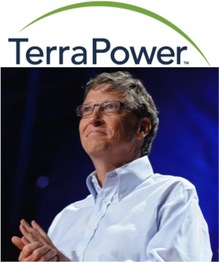
Reprocessing of spent nuclear fuel is practiced in the U.K., France, Japan, India, and Russia but was banned in the U.S. back in the mid 70s under both the Ford and Carter administrations. The fear has been other countries using these same reprocessing techniques to extract plutonium for non-civilian purposes.
And so, as of today, an estimated 64,000 tons of spent fuel has accumulated and sits on the sites of 65 U.S. nuclear generating power stations. These materials will remain radioactive for thousands of years. Reprocessing nuclear fuel --a process by which plutonium is extracted and then converted into MOX nuclear fuel that can be used back in the same traditional nuclear reactors-- would reduce the volume of high-level nuclear waste by about 20 percent, and levels of radioactivity from the waste of reprocessing also decay much faster. But that would still leave 80 percent of high-level waste sitting on the sites of nuclear plants.
TerraPower, backed by Bill Gates, is working on a reactor that would allow the nuclear fuel to remain inside the core, while slowly undergoing fission for 40 years vs. the typical one and a half to two years in currently operating U.S. reactors. In that scenario, one would only need to worry about spent fuel storage every 40 years, at which point the spent fuel rods would have already reached a very low level of radioactivity.
~~~~~~~~~~~~~~~~~~~~~~~~~~~~~~~~~~~~~~~~~~~~~~~~~~~~~~~~~~~
Futuristic U.S. Power Reactor May Be Developed Overseas
By Peter Behr
The New York Times
06/31/2011
The TerraPower "wave reactor" concept is backed by Microsoft's Bill Gates, is endorsed by Republican presidential hopeful Jon Huntsman Jr. and has gotten a receptive ear from President Obama's Energy Department.
But it's headed overseas for its next crucial step, if ongoing negotiations with a foreign sponsor are successfully completed, says Roger Reynolds, TerraPower's technical adviser.
The Bellevue, Wash., startup says it has verified the theory behind its slow-burning reactor through supercomputer simulations and now needs to build a pilot version of the reactor, to evaluate how the metal fuel casings in the core will withstand decades of radioactive bombardment.
The reactor is designed to run for 40 years or more without refueling as it steadily consumes most of its original fuel supply. Thus it remains intact, disarming concerns about long-term spent fuel storage or the theft of nuclear material during refueling or fuel reprocessing, the company said.
Reynolds said the plant won't be built in the United States.
"We've had conversations with the Chinese, the Russians, the Indians, the French," Reynolds said in an interview. "We have an aggressive schedule where we think it is important to get something built and accumulate data so that we can eventually build them in the U.S. Breaking ground in 2015, with a startup in 2020, is more aggressive than our current [U.S.] regulatory structure can support."
Read full article here
And so, as of today, an estimated 64,000 tons of spent fuel has accumulated and sits on the sites of 65 U.S. nuclear generating power stations. These materials will remain radioactive for thousands of years. Reprocessing nuclear fuel --a process by which plutonium is extracted and then converted into MOX nuclear fuel that can be used back in the same traditional nuclear reactors-- would reduce the volume of high-level nuclear waste by about 20 percent, and levels of radioactivity from the waste of reprocessing also decay much faster. But that would still leave 80 percent of high-level waste sitting on the sites of nuclear plants.
TerraPower, backed by Bill Gates, is working on a reactor that would allow the nuclear fuel to remain inside the core, while slowly undergoing fission for 40 years vs. the typical one and a half to two years in currently operating U.S. reactors. In that scenario, one would only need to worry about spent fuel storage every 40 years, at which point the spent fuel rods would have already reached a very low level of radioactivity.
~~~~~~~~~~~~~~~~~~~~~~~~~~~~~~~~~~~~~~~~~~~~~~~~~~~~~~~~~~~
Futuristic U.S. Power Reactor May Be Developed Overseas
By Peter Behr
The New York Times
06/31/2011
The TerraPower "wave reactor" concept is backed by Microsoft's Bill Gates, is endorsed by Republican presidential hopeful Jon Huntsman Jr. and has gotten a receptive ear from President Obama's Energy Department.
But it's headed overseas for its next crucial step, if ongoing negotiations with a foreign sponsor are successfully completed, says Roger Reynolds, TerraPower's technical adviser.
The Bellevue, Wash., startup says it has verified the theory behind its slow-burning reactor through supercomputer simulations and now needs to build a pilot version of the reactor, to evaluate how the metal fuel casings in the core will withstand decades of radioactive bombardment.
The reactor is designed to run for 40 years or more without refueling as it steadily consumes most of its original fuel supply. Thus it remains intact, disarming concerns about long-term spent fuel storage or the theft of nuclear material during refueling or fuel reprocessing, the company said.
Reynolds said the plant won't be built in the United States.
"We've had conversations with the Chinese, the Russians, the Indians, the French," Reynolds said in an interview. "We have an aggressive schedule where we think it is important to get something built and accumulate data so that we can eventually build them in the U.S. Breaking ground in 2015, with a startup in 2020, is more aggressive than our current [U.S.] regulatory structure can support."
Read full article here

 RSS Feed
RSS Feed